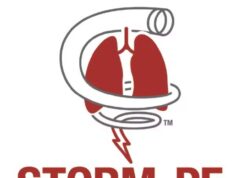Aidoc, a technology company that provides artificial intelligence (AI) solutions for medical imaging, including in the cardiovascular space, is extending its services beyond the radiologist’s workstation. This is according to the company’s vice president of Innovation, Demetri Giannikopoulos, who spoke to Interventional News at this year’s International Symposium on Endovascular Therapy (ISET 2022; 16–19 January, Hollywood, USA) about the company’s journey and its place in a growing market.
With seven US Food and Drug Administration (FDA) clearances for a variety of pathologies, Aidoc states that its AI algorithms deliver a cross-specialty AI experience for physicians in nearly 600 medical centres across the globe.
Specifically, the company’s suite of solutions includes providing thoracic radiologists triage and notification tools to help identify positive cases of pulmonary embolism (PE). This identification by Aidoc’s AI process is combined with automated right ventricle/left ventricle (RV/LV) ratio calculations, provided by partner company Imbio’s software, to improve patient severity assessment and expedite treatment.
“AI is everywhere,” says Giannikopoulos, who notes that what makes it “transformational” in medicine is its ability to help to shape patient care plans and pathways. The technology can be leveraged to identify the appropriate patients for treatment and bring those patients to the care team in a timely manner, he explains.
Aidoc started in diagnostic radiology. The company’s solutions would automatically flag any positive cases of acute pathologies on the scans, and then prioritise the patients with those positive cases on radiologists’ worklists. “The radiologists would have earlier awareness of the patients with positive acute findings,” Giannikopoulos tells Interventional News.
The company has been extending its AI solutions beyond the radiologist’s work station and connecting radiologists’ findings with the multidisciplinary teams (MDTs) that directly care for the patients, Giannikopoulos reveals. He elaborates: “The focus now is on driving awareness from the radiologist directly to the emergency care physician, directly to the interventionalist, so they know that there is a patient that is worth evaluating immediately.”
“The opportunity for PE patients to fall through the cracks is significant,” says Giannikopoulos, alluding to one of the key reasons why the company endeavours to become more involved in direct patient care. “A lot of times PE is managed by the bedside physician without consulting with the interventional team,” he adds. “We are alerting the team based on the PE identification in the image plus the RV/LV analysis.”
While AI has the potential to improve patient care, Giannikopoulos acknowledges the importance of “pulling the signal from the noise” amidst a growing pool of evidence in the field and fragmented care pathways, and underlines various challenges associated with standing out in a crowded market. He believes that the level of integration Aidoc currently has with the clinical care team sets the company apart, referencing in particular Aidoc’s immediate access to both imaging results and patient information, which can be quickly transferred to team members by their mobile devices.











